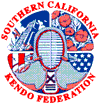
Guidelines for Promotion
At the SCKF shinkyu shinsa (promotional examination),
examiners base their evaluations of examinees on evidence of an appropriate
level of technical proficiency and stability acquired through the course of
their study.
The central concern is the level of kihon (fundamental techniques)
demonstrated by the examinee. Each higher grade requires an increasing level
of proficiency in basic techniques.
Higher grades should also exhibit more advanced techniques and
strategic skills, as well as increased mental and physical discipline.
Points for Observation
At the shinkyu shinsa, examiners evaluate candidates for promotion.
The examiner's responsibility is to make a rank level decision for kyu ranks
and a pass-fail decision for yudansha ranks,
based on an increasing accumulation of the following points:
- chakuso (proper wearing of keikogi, hakama, bogu)
- reiho (appropriate manners and deportment)
- shisei (posture)
- kamae kata (way of holding the shinai)
- ashi sabaki (footwork)
- kiai and kakegoe (vocalizations)
- kihon datotsu (basic strike) and hasuji (angle of cut)
- maai (distance to opponent)
- zanshin (feeling after the strike)
- ki-ken-tai-no-ichi (spirit, shinai, body as one)
- datotsu no kikai (opportunity to strike)
- waza (techniques)
In addition to the above points, for kata the following points apply:
- Uchidachi has the role of teacher (leader), shidachi the role of student.
Uchidachi calls "yah", shidachi calls "toh".
- From beginning to end there should be no relaxing of concentration.
Proper metsuke (gaze) is maintained throughout the kata.
- Ashi sabaki generally moves forward with the leading foot and
backward with the trailing foot. Ashi sabaki should be silent, with toes
down.
- Shidachi's maai should be such that the monouchi reaches the target area.
- Zanshin should be asserted with strong kigurai.
Guidelines for Examiners
- For each kenshi, use the provided evaluation forms to mark areas that
are sufficient or that need improvement.
Also, fill in comments where appropriate.
- The head examiner on each court should ensure sufficient time for all
examiners to complete their evaluations for a given group
before moving on to the next group.
- For kyu ranks, record the numerical grade you feel is appropriate based
on the kendo demonstrated by the kenshi.
- For dan ranks and for kata, record "Y" or "N" to pass or fail the
kenshi, based on the kendo or kata demonstrated by the kenshi.
Examiners may find the following points useful in their evaluations:
- kenshi's current rank level and year received.
If skipping one or more ranks, does the kenshi perform at a sufficient
level to justify the rank increase?
- kenshi's age and, for young kenshi, size. Does the kenshi display
a sufficient level of maturity to perform on par with their peer group?
Rules for Requesting Ranks
- Kenshi must be currently training in full bogu.
This includes those requesting youth 6 kyu, youth 5 kyu, and adult 4 kyu.
These groups do not participate at the shinsa purely as a time saving
measure, but they should be capable of doing so.
- 12 years and older cannot request 6 kyu
- 14 years and older cannot request 6 kyu or 5 kyu
- kyu requests may include "plus" or "minus", e.g. 6+ kyu or 5- kyu
- to request 1 dan must be 1 kyu and 14 years or older
- to request 2 dan must be 1 dan for at least 1 year (12 months)
- to request 3 dan must be 2 dan for at least 2 year (24 months)
- to request 4 dan must be 3 dan for at least 3 year (36 months)
Recommended Guidelines for Requesting Ranks
- kenshi should be actively practicing kendo (regularly attending keiko
at least once or twice a week)
- avoid "skipping" more than one rank or at most two rank levels,
(for example, avoid 0 kyu requesting 2 kyu or 1 kyu)
except in extremely rare circumstances.
- avoid "throwing the decision to the examiners".
The responsibility of the dojo's head instructor and advisors is to
make a diligent assessment of the kenshi's attitude and sincerity in
practicing kendo,
as well as their skill level relative to other kenshi in the federation,
and request a rank appropriately.
- although the rules state that a kenshi requesting a rank who is 14 years
or older must request 4 kyu or higher, this does not mean a
kenshi 14 and older must request a rank. The head instructor should
determine whether the kenshi has sufficient experience to warrant a
rank of 4 kyu, or whether to keep the kenshi at 0 kyu.
Rules for Testing Outside SCKF
A kenshi who wishes to test outside of SCKF may do so only at an
FIK-affiliated federation.
Kenshi must receive permission from their head instructor and written
permission from the SCKF President prior to applying for the outside test.
They may also need to pay a fee to SCKF.
Any rank received outside SCKF without prior authorization, or from a
non-FIK-affiliated federation, will not be recognized by SCKF.
|

